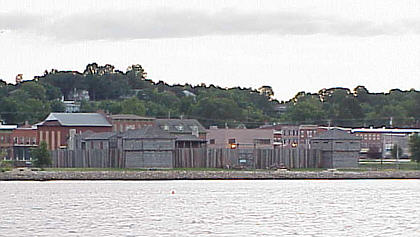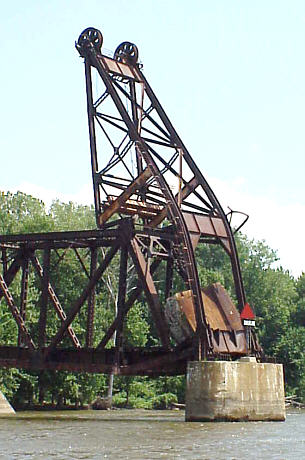| Page 2
 So what’s different on this trip? First off the Mississippi is
not the same here as farther south. It has the appearance of being
more lake like. The shoreline is fairly flat but mostly devoid of
jagged rip-rap that lines the banks to the south. Plus almost every
bank is covered to the water line with stands of large trees giving the
impression of thick forest. I know in many cases behind these are
farm fields but few are actually visible from the water.
So what’s different on this trip? First off the Mississippi is
not the same here as farther south. It has the appearance of being
more lake like. The shoreline is fairly flat but mostly devoid of
jagged rip-rap that lines the banks to the south. Plus almost every
bank is covered to the water line with stands of large trees giving the
impression of thick forest. I know in many cases behind these are
farm fields but few are actually visible from the water. (Photo is one of the many Casinos on the Upper Mississippi) Also, in many places it is quite wide – over a mile occasionally. Then there are sections that the main channel is fairly narrow but there are sloughs and islands all over the place. Again all covered with a thick growth of trees. Then there is the current. I frequent the section of the Mississippi between the Kaskaskia River mouth and St Louis and know there the current is strong. I had attributed it to the fact that nearby to the north both the Illinois River and the Missouri River converge with the Mississippi. But now I am above both of those rivers and the current is still surprising strong. I estimate it to be between 2 to 3 MPH which is about the same as below the two rivers. Also, the river is rather shallow as the depth only ran from about 13 to 18 ft deep. Another change is the locks themselves. Unlike most of the locks I have passed through on other trips none of them, except Keokuk, have floating bollards or pins to tie off to when in the lock. They just have ropes that the lockmasters would drop down so I could more or less secure the boat during lockage. And strangely the rules on their use seemed to vary from lock to lock. Usually when being raised in the lock they would drop a line but not always (there is more turbulence in the chamber when filling than when empting). Sometimes I would enter and no one would offer the line so I just floated in the center. Often when being lowered this was the case but then every once in a while they would request I grab a rope. Basically, I just had to wait and see what the procedure was at that particular lock.  Another BIG change was that Pleasure Boats (often called Rec Boats when
communicating with the locks) are given priority for locking. When
I would pull up to a lock and a tow was getting ready to exit, even though
there might be one or more tows already sitting waiting for the lock, they
would run me through first!
Another BIG change was that Pleasure Boats (often called Rec Boats when
communicating with the locks) are given priority for locking. When
I would pull up to a lock and a tow was getting ready to exit, even though
there might be one or more tows already sitting waiting for the lock, they
would run me through first! (Photo is Fort Madison, IA) It appears the reason for this is the nature of the lock system on this part of the Mississippi. Again, with the exception of the lock at Keokuk, IA, every one has a chamber size of 600 X 110. In the 1930’s when all these were built this was fine but by today’s standards they are rather small. Almost every tow that passes through these are twice that size and have to be broken into two pieces and handled as a double lockage. Fortunately, the drop/raise at most of these locks is not great so turnaround times are better than at some locks. But still it takes 2 1/2 to 3 hours for each tow to complete the passage ( On the Tennessee River minimum time was usually 4 hours). Rec Boats on the other hand can run through much quicker and only delay things by about 30 to 40 minutes. My guess it is for that reason that they allow them to move ahead of the tows. I really didn’t want to ask over the radio, as I was afraid that some tow captain would feel I was rubbing salt in the wound. I thought that humility was the best course of action when these guy's boat out weighs mine about a million to one! It was a huge benefit though. On the return trip at Lock 24 there were six southbound and three northbound tows waiting when I pulled up. I waited about 30 minutes for a tow to finish and locked through. Had I been on the Tennessee River I would have had to wait my turn just like the tows. Let’s see 9 X 3 = 27 hours wait. Thirty minutes is definitely better!!! Speaking of the locks, there was another problem I had not encountered before. I mentioned the current was strong and this held true at the locks. On the lower or downstream side it was more pronounced. Also, the water flowing over the dams produced a lot of turbulence. Lock 16 was by far the worst. It was producing waves in the 2’ to 3’ range.  Plus, trying to get an anchor to hold was near impossible. I assume
this was because the fast churning water more or less swept the bottom
clean leaving nothing but hard clay. My anchors just wouldn’t bite.
At one point at Lock 16 I was over near the shore in 5’ of water with 80’
of rope out and it just drug my 16 lb river anchor along.
Plus, trying to get an anchor to hold was near impossible. I assume
this was because the fast churning water more or less swept the bottom
clean leaving nothing but hard clay. My anchors just wouldn’t bite.
At one point at Lock 16 I was over near the shore in 5’ of water with 80’
of rope out and it just drug my 16 lb river anchor along.I found in order for it to hold at all I would have to back away almost a mile where there was less current and turbulence. Each time I would explain my situation to the lockmaster and they would just give me an advance call when it got close to my turn in the lock. Since they were kind enough to allow me to cut in line I sure didn’t want to hold things up while I made my way to the lock. I made sure I was always there and waiting when it was my turn. Coming downstream was better. There was no turbulence but still getting the anchor to hold could be a problem. But here backing a way a little and getting off to the side usually worked out. (This photo shows what happens when the cables fail on a lift bridge's counterweight!) |